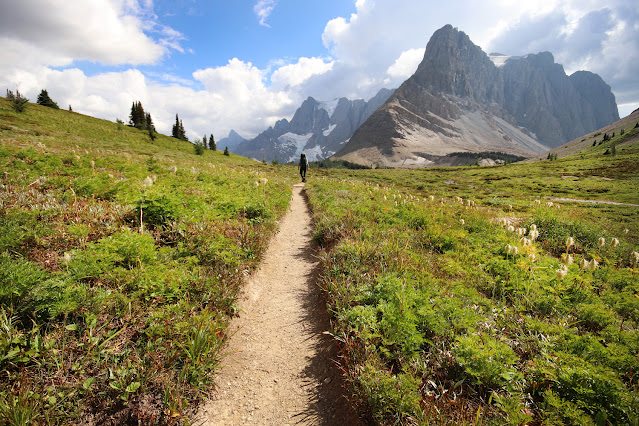“It will only take about 10 or 20 minutes tops,” says my
boyfriend Mirko.
“No way,” I reply. “It’s at least half an hour or 45 minutes
one way.”
I look nervously at the dark clouds looming in the distance,
grab my raincoat and put a cover over my giant backpack that has everything
needed to survive in the wilderness for four days. Mirko decides to just take
his camera, convinced we’ll be back in no time.
Our sights are set on reaching a waterfall perched along the edge of the hanging glacier. The route to the waterfall looks relatively easy, but we soon find ourselves hiking in mud up steep terrain and over rocky ledges with nothing to grab onto.
Forty-five minutes later, the waterfall is still out of reach (and sight) as we approach the lower part of the large glacier in a vast landscape of rock, mud and ice. The clouds that were looming in the distance have now moved in, causing us to abort the waterfall mission and head back to our packs. Now it’s a race against time.
As we scamper across the muddy terrain, the wind starts howling and the clouds spit rain. Fortunately, the downpour holds off until we’re near our packs, where we’re met with a crack of thunder that rumbles through the valley. Filled with adrenaline and fear, we slide down the rocky moraine and head for the nearest patch of trees.
“This is crazy!” I say, as we huddle under small larch
trees, trying to escape the sideways rain.
Being in the backcountry of the Rocky Mountains during a thunderstorm is a scary and exhilarating experience – and one we encountered three more times during the four days and three nights spent hiking the famous Rockwall Trail near Radium, B.C.
Spanning 55-kilometres, the trail traverses through subalpine meadows, hanging glaciers, over four mountain passes and a gorgeous turquoise lake. The defining feature is the rockwall – a single massive limestone cliff that borders most of the trail and rises 2,953 feet in some places.
I added the hike to my backcountry adventure list after seeing a breathtaking photo of Floe Lake several years ago. I knew I had to see the turquoise lake sitting beneath a massive wall of rock, even though reserving one of the few backcountry campsites along the trail is like winning the lottery.
Fortunately, I was one of the few lucky people who managed
to reserve three nights along the trail at the other backcountry campgrounds,
but not at Floe Lake. This meant our last day would be a 20 km hike back to the
car, instead of 10 km if we camped at the lake for a night.
Nonetheless, Mirko and I were pumped about travelling from
Victoria to tackle one of the most beautiful and challenging hikes in the
Canadian Rockies, where the weather is often unpredictable. On one backcountry
hiking adventure near Banff a few years ago, I couldn’t even see the mountains
for three days due to rain and low cloud cover, which was very disappointing.
During the first two days on the Rockwall Trail, we were treated with warm weather and sunny skies, allowing us to soak in the open meadows dotted with colourful wildflowers along the Rockwall Pass.
We saw two grizzly bears – one in the ditch eating berries near the trailhead (we watched from the safety of our car), and another jumped out of the bushes as we approached the Helmet Falls Campground. This caused me to let out a scream I didn’t even know I was capable of making.
The fourth day is what I was looking forward to the most
since we would be hiking over Numa Pass (the highest point on the Rockwall
Trail at 2,355 metres) and then descending to Floe Lake, which is the highlight
for many people. But an intense thunderstorm overnight (which is nerve-wracking
when you’re in a tent) set the tone for what we would face the next day.
Leaving camp early under cloudy skies, we start counting in
German to make noise and alert any grizzly bears in the area about our presence.
The area around Numa Creek is known for high grizzly bear activity, and the stories
about bear encounters and sightings from other hikers we met along the trail pushed
my fear of bears into overdrive.
Shortly after passing through an avalanche chute, the next thunderstorm rolls in with heavy rain. Closer to Numa Pass, we’re greeted with bone-chilling temperatures and pelted with sideways rain and snow.
“Are you having fun?” I ask Mirko, as we briefly shelter
under a small patch of trees before heading over the exposed mountain pass
that’s blanketed in fog. I shiver uncontrollably while trying to eat a Cliff
bar. Mirko’s also struggling to stay warm. It’s hard to believe it’s mid
August.
Eventually we brave the wild weather and hike over the pass,
where we get our first foggy view of Floe Lake in the rain. It looks like a
jewel in this miserable weather that makes us want to hike faster to the car. I
think about the photo that inspired me to come here, and can’t help but feel
disappointed we don’t get to see Floe Lake on a clear day.
“We’ll just have to come back and see it another time,” says
Mirko. “The Rockwall Trail lets you experience the soul of the Rocky Mountains. Rocks, sunshine, glaciers, grizzlies, meadows,
thunderstorms, breathtaking views, mosquitoes, steep ascents give a taste of
the harsh and unforgiving beauty of these mountains.”
WATCH VIDEO: Four days hiking along the Rockwall Trail





